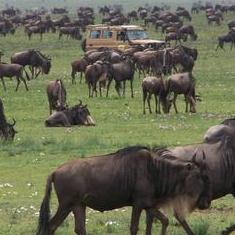 坦尚尼亞政府已批准一條商用高速公路的建造計畫,這條由阿魯沙(Arusha)至穆索馬(Musoma)的公路,東西橫跨坦尚尼亞歷史最久且最受歡迎的塞倫蓋蒂(Serengeti)國家公園,這裡也是聯合國教科文組織所列冊的世界遺產。此外,該公路也將切斷塞倫蓋蒂野生動物大遷徙的路線,這是同類型大遷徙中全世界僅存的一條。
坦尚尼亞政府已批准一條商用高速公路的建造計畫,這條由阿魯沙(Arusha)至穆索馬(Musoma)的公路,東西橫跨坦尚尼亞歷史最久且最受歡迎的塞倫蓋蒂(Serengeti)國家公園,這裡也是聯合國教科文組織所列冊的世界遺產。此外,該公路也將切斷塞倫蓋蒂野生動物大遷徙的路線,這是同類型大遷徙中全世界僅存的一條。
「上百萬隻牛羚...由同樣的古老節奏所驅動,依照他們的本能,進入無可避免的生命週期中:為期三個星期的瘋狂行動,爭奪著交配權與領域。每年長達40公里的隊伍,將通過鱷魚出沒的水域,向北移動...」
保育與生態學者都已站出來反對公路的興建。非洲野生動物基金會和國際野生生物保護學會坦桑尼亞分會都反對興建道路。他們支持另一條往南方的替代路徑,可以繞過公園,並且可以為更多的城鎮帶來幫助。
坦桑尼亞總統基奎特(Jakaya Mrisho Kikwete)於7月31日宣布,高速公路的計畫將繼續發展,基奎特總統在每月底固定的演說中,發布了這項消息,這是在10月底大選前最後一次的固定演說。
自然資源與旅遊部長旺根加(Shamsa Mwangunga)在7月3日告訴公民報(The Citizen)說,政府有義務履行基奎特總統在2005年競選時的承諾,完成阿魯沙-穆索馬道路的建設。
旺根加說,道路建設並不會如同反對者所宣稱的,干擾野生動物的年度遷移。
在480公里的道路中,有53公里將穿越園區北部-牛羚的敏感地帶,牛羚多年來利用此區域作為往北遷移至肯亞馬賽馬拉(Masai Mara)保護區的避難所。
保育人士警告,重型卡車將造成人類與野生動物的事故;將棲地破碎化,並改變水文與土壤系統;增加外來動物病源風險與外來種植物入侵,而且也會增加組織犯罪的盜獵行為。
旅遊業專家警告說,改變公園以及動物的遷徙路線,將會破壞坦尚尼亞的形象,並且重創旅遊業,危及數百萬先令的外匯收入。
在政府計畫道路興建之際,市場調查已經完成,但如果啟動公路建設,旅遊業專家認為遊客可能會抵制坦桑尼亞。
在德國,法蘭克福動物學會(FZS)警告說,「計劃中的商業道路將成為東非各大港口之間的主要連結,例如蒙巴薩(Mombasa)、達累斯薩拉姆(Dar es Salaam)、坦噶(Tanga )以及其他快速發展的中非國家。隨著未來幾年非洲貿易量快速的增長,每天會有數百輛大型卡車穿越塞倫蓋蒂。」
「道路將全世界大型哺乳動物密度最高的區域切開,使得人們必須興建圍籬以避免野生動物引起的車禍造成車輛的損壞以及人命的損失。這樣的圍籬終將使大遷徙結束,牛羚、斑馬、大羚羊和大象在乾季無法抵達他們唯一的水源-馬拉河,而死在圍籬旁。」FZS的執行主任申克(Christof Schenck)博士以及FZS非洲計畫主持人伯納(Markus Borner)博士警告。
「博茨瓦納(Botswana)已經因為這類圍籬失去了牛羚和斑馬的遷徙。在加拿大,班夫(Banff)國家公園的麋鹿遷徙也受到道路的影響,」FZS官員說。「這些地區並不是特例,道路在全球許多的原始荒野地區都造成了類似的破壞。」
The Tanzanian government has approved plans to build a commercial highway running east-west across Serengeti National Park, Tanzania's oldest and most popular national park and a UNESCO World Heritage Site. The planned road from Arusha to Musoma would cut across the routes of the great Serengeti wildlife migration - the last of its kind in the world.
"A million wildebeest... each one driven by the same ancient rhythm, fulfilling its instinctive role in the inescapable cycle of life: a frenzied three-week bout of territorial conquests and mating; survival of the fittest as 40km (25 mile) long columns plunge through crocodile-infested waters on the annual exodus north..."
Conservationists and ecologists are mobilizing to fight the highway. The African Wildlife Foundation and the Wildlife Conservation Society of Tanzania both oppose the road. They support an alternative route to the south that would bypass the park and that they say would serve many more Tanzanian towns and villages.
On July 31, Tanzania's President Jakaya Mrisho Kikwete announced that the planned highway would move forward. President Kikwete made the announcement in his regular end of the month address, the last one before the general elections in October.
Minister for Natural Resources and Tourism Shamsa Mwangunga told "The Citizen" newspaper on July 3 that the government is obliged to fulfil a campaign promise, made by President Kikwete in 2005, that his administration would complete construction of the Arusha-Musoma road.
Mwangunga said construction of the road would not disturb the popular annual wildlife migration as campaigners claim.
Fifty-three kilometers of the planned 480 kilometer highway would cross the northern section of the park - a critical area for the wildebeest, which use it as a refuge for much of the year and migrate north into Kenya's Masai Mara Reserve.
Conservationists warn that heavy truck traffic will result in loss of wildlife and human life through accidents; fragmentation of habitat and alteration of water and soil systems; increased introduction of animal disease and alien plant life and increased wildlife poaching by organized gangs.
Travel industry experts have warned that the resulting changes in the Serengeti and the migration would damage Tanzania's image and harm its tourist industry, jeopardizing millions of shillings in foreign exchange.
Survey markers are already in place along the government's planned route, but if highway construction were to be started, travel industry experts say visitors would likely boycott Tanzania.
In Germany, the Frankfurt Zoological Society warns, "The planned commercial road will become a major link between East African ports like Mombasa, Dar es Salaam or Tanga and the fast developing Central African countries. With trade growth rates rising immensely in Africa, transport will significantly increase within the next few years causing hundreds of heavy trucks to cross the Serengeti every day."
"The road bisects an area with the highest concentration of large mammals in the world, making it evident that fencing would be needed to avoid damage to vehicles and loss of human lives caused by accidents with wildlife. Such fencing would truly mean the end of the migration as wildebeest, zebras, eland and elephant could no longer reach their only water source during the dry season, the Mara River, and thus would die at the fence-line," warn FZS Executive Director Dr. Christof Schenck and Dr. Markus Borner, director of the FZS Africa Programme.
"Botswana has already lost its wildebeest and zebra migration due to such fences. And in Canada, the elk migration in Banff National Park was also compromised because of a dissecting road," say the FZS officials. "These areas are not isolated examples, roads have caused similar destruction in many pristine wilderness areas across the globe."
全文及圖片詳見:ENS報導



